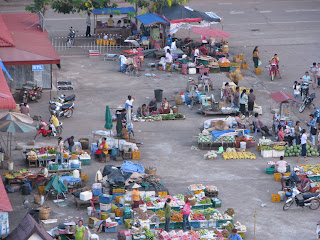 We picked up in Tat Lo where we left off in Si Phan Don - relaxing on the front porch of our hut overlooking the river. Except now we had traded the sweltering heat of the valley for the cool breezes of the Bolaven Plateau, and the wide, slowly meandering Mekong for a more agile network of rivers that tumble over the highlands in a series of waterfalls.
We picked up in Tat Lo where we left off in Si Phan Don - relaxing on the front porch of our hut overlooking the river. Except now we had traded the sweltering heat of the valley for the cool breezes of the Bolaven Plateau, and the wide, slowly meandering Mekong for a more agile network of rivers that tumble over the highlands in a series of waterfalls.Although we were joined by a handful of travelers on the long and sweaty bus ride to Tat Lo, the place seems to have retained much of its traditional character. There are no Internet cafes or western-style restaurants
 - just a few local shops, a collection of huts for travelers and a small temple, which was blasting music at all hours of the day and night for a local festival while we were there.
- just a few local shops, a collection of huts for travelers and a small temple, which was blasting music at all hours of the day and night for a local festival while we were there.The area is famous for two things: waterfalls and coffee. In our short time there, we got a small taste of each. There were two waterfalls within walking distance of our hut, where we could take a refreshing dip or watch the local boys slip down naturally carved water slides into swirling water below. A short hike beyond the waterfalls b
 rought us to small tracts of farmland clear-cut from the thick forest. In addition to growing coffee, the local tribal people plant a wide range of other crops to support their small villages.
rought us to small tracts of farmland clear-cut from the thick forest. In addition to growing coffee, the local tribal people plant a wide range of other crops to support their small villages.The Plateau was an incredibly pleasant detour and we wish we had more time to explore the area, but we now had a flight to New Zealand booked and not much leeway in our schedule. So, we headed back to Pakse to try to arrange transport up north. It worked out that we had an extra day in the city, so we rented a fantastic hotel room (a big splurge at $17 a night!) and took advantage of "big city" amenities, like an ATM.
There isn't too much to do in Pakse, but it's a
 pleasant enough place if you can find somewhere to hide from the mid-day sun. We picked a local "healing center", where we got traditional Laos-style massages laying on mattresses on the floor. It was a far cry from a spa-like setting and the masseuses kept laughing at us, but at least there was air conditioning! This riverside city also boasts a few pretty temples, a small market and, of course, a couple of excellent coffee shops. By 10 pm we were exhausted and ready to sleep the night away on our overnight bus to Vientiane.
pleasant enough place if you can find somewhere to hide from the mid-day sun. We picked a local "healing center", where we got traditional Laos-style massages laying on mattresses on the floor. It was a far cry from a spa-like setting and the masseuses kept laughing at us, but at least there was air conditioning! This riverside city also boasts a few pretty temples, a small market and, of course, a couple of excellent coffee shops. By 10 pm we were exhausted and ready to sleep the night away on our overnight bus to Vientiane.



